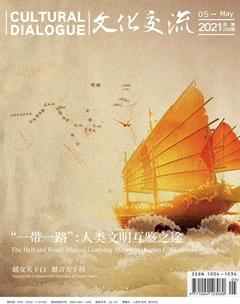越劇:江南靈秀出鶯唱
陸遙

從落地唱書到女子科班,從山歌民謠到悠悠清韻,她在江南秀美的山水田園中孕育,她的精氣神沾染了吳越民間生活的煙火氣,與江南百姓的文化血脈相依相偎、相輔相成。經過114年的傳承發展,她不僅有幾百出傳統和現代的優秀劇目,數以億計的忠實觀眾,還擁有一批享譽全國的著名表演藝術家。
她,便是越劇。
作為中國主要的地方性大劇種,也是流傳最廣的地方劇種,越劇書寫了中國戲曲史上鄉音流變的神話。“越劇的歷史,其實就是中國百年社會變革的歷史。”鐘冶平與越劇結緣三十余年,導演了《百年越劇》《舞臺姐妹》等耳熟能詳的越劇紀錄片。這一次,我們跟隨他的講述,細細觸摸越劇源起、傳承與發展的年輪。
回腸柔曲出嵊州
越山剡水清悠悠,回腸柔曲出嵊州。尋訪越劇的蹤跡,還得從她的發源地——嵊州市甘霖鎮東王村開始。
四個稻桶,兩扇門板,搭出一張簡陋的越劇戲臺。我們圍著八仙桌面對而坐,鼻尖縈繞著香火堂的裊裊煙味,目光流轉著揚舞的水袖、飄逸的臺步,耳畔流淌著悠揚的旋律、清婉的唱腔。
舉目四望,墨綠的青苔悄然爬上了屋頂的黑瓦,填補了樟木材飽經日月風霜后綻開的一道道皸裂。一塊刻畫著“嵊州市文物保護單位:越劇誕生地”的石碑矗立著,碑上灰白的紋理、斑駁的刻痕仿佛跨越了時光長河,將百年越劇的歷史帶到我們眼前。
一步腳印一滴汗水,一鍬黃土一句唱書。當年的嵊州百姓在田間隴上勞作時,依據民間演義的故事、當地的小道消息或自身的生活經歷,信手拈來編成一些生動有趣的即興唱段,瑯瑯上口,活靈活現。鐘冶平介紹說:“這種唱段主要以當地流行的宣卷調為主,糅合了牧牛調、蓮子行等民歌小調,因為用‘四工合上尺當作尾襯,所以當地人都叫它‘四工合調。”
1906年清明節前夕,東王村李世泉、高炳火、錢景松等一批剛從臨安外伍村演出回來的民間藝人,經過精心準備,在東王村香火堂前用四只稻桶墊底,再鋪上門板,上臺演出了《十件頭》《倪鳳扇茶》《雙金花》等戲,越劇在這個小村莊里橫空出世,掀開了中國戲曲史的新一頁。
據《紹興市志》記載,早期的越劇因只用篤鼓、檀板按拍擊節,的篤之聲不斷,又稱“小歌班”“的篤班”。小歌班因其演出不拘條件,能送戲上門,深入山莊小村演出,且戲班人員少,好接待,不計較報酬,受到當地百姓的歡迎。有民謠作證:“小歌班、吊腳板,男人看了懶出畈。女人看了懶燒飯,自格小囡忘記還。”
“越劇從她誕生的那一天起,就飽含著吳越文化的真摯情感和之江大地的泥土芳香。”在發源地講越劇故事,鐘冶平感觸頗深。
“湖月照我影,送我至剡溪”,是李白夢游天姥山,陶醉于嵊州的山水之間的雅興。盛唐時,有400多位詩人在越鄉留下了1000多首瑰麗詩作,將文明的種子播撒在剡溪兩岸的曠野鄉間,形成了越鄉民間文化的深厚積淀。也許只有這樣唐詩之路的山水,才能孕育出水樣柔情的越劇。
行走在靜臥山間的東王村,我們仿佛重新閱讀越劇的百年演義。越劇的誕生已在世代相傳間,沉淀成村莊不老的故事,年代或事件的綱目依然清晰,仍是鄉間農人熟稔的內容。戲服、工具、蓑衣、曬匾等,村里陳列著老物件的展示館就像一圈全年輪,再現當地老百姓曾經的鄉村生活。
清麗越音傳四方
如果當年的越劇僅僅滿足于自娛自樂和田頭歌唱,僅僅停留在寧紹平原和杭嘉湖平原,就不可能有以后的發展和今天的輝煌。
車停在嵊州鹿胎山南麓的越劇博物館,這里和譽有“越劇藝術家搖籃”之稱的越劇之家相連。
“我們的博物館剛過30歲生日!”越劇博物館館長俞偉驕傲地介紹,作為中國第一家專業戲曲博物館,嵊州越劇博物館于1990年10月18日開館。
眼前的白色建筑物巍峨矗立、氣勢磅礴,一下子就把人帶進了百年越劇的輝煌歷程中。庭院內擺有一塊刻有“百年越劇”的石碑。踱步入院,映入眼簾的便是袁雪芬、尹桂芳等越劇老藝術家們的銅像,在午后秋日金色暖陽的映照下,煥發出瑩瑩光輝。一幅幅老照片,一張張老報紙,一件件舊行頭……館內彌足珍貴的實物,仿佛一個個清晰的腳印,真實記載了越劇發展的藝術軌跡。
“越劇第一次上臺演出時,藝人一不會走臺步,二不會做身段,‘唱做念打樣樣不懂,‘手眼身法步也沒有掌握,更談不上‘四功五法的運用了。”俞偉說,小歌班演員虛心向姚劇、紹劇的大班子請教,“小歌班早期穿戴大多數借用生活中的衣衫、長袍、馬褂,學習了大班子的傳統樣式后,把租來的戲裝放在篾簍里,挑著走村跑鎮,這是小歌班最早出現的衣箱形式。”
以《碧玉簪》《梁山伯與祝英臺》等優秀劇目為先導,小歌班敲開了上海這個繁華大都市的大門。在展廳透明的玻璃窗內,一張泛黃的《申報》攤開在桌面上。“1922年8月,以王永春、白玉梅、馬潮水為首的越劇戲班進入到上海‘大世界演出,《申報》當天廣告刊出‘紹興文戲之名,因此越劇又被稱為‘紹興文戲。”俞偉說,小歌班原來是沒有伴奏樂器的清唱藝術,唱腔尾聲拖腔是用人聲幫腔,常以“呤哦呤呤哦”唱出。后來組成了以鼓板、板胡、斗子三件樂器組成的“三件頭”樂隊,以絲弦伴奏替代人聲幫唱,唱腔尾聲幫腔,更為文雅完整了。
越劇博物館是越劇的一面鏡子。“尺調弦下哀婉情,起調拖腔意無窮。江南靈秀出鶯唱,啼笑喜怒成雋永。”越劇的第一聲唱嘆就裊娜在人們的耳邊,由嵊州向杭州、向上海輻射到全國乃至世界,訴說著越劇文化千尺深潭般的底蘊。
“越劇從浙東山村走進紹興、寧波、杭州,闖進上海后一鳴驚人,不是一帆風順的。”鐘冶平補充說,越劇發展到今天有兩點不可忽視:一是越劇走出了地域的局限,順應了時代的發展。二是自覺接受了先進文化的熏陶。
從嵊州出發,經過1個多小時的車程,我們來到了70公里外余姚四明山的浙東行政公署舊址。1943年7月后,為了適應抗日宣傳的需要,浙東區黨委決定以革命知識青年為主體,吸收一批越劇老藝人,建立一支革命化、群眾化、男女合演的越劇隊伍,定名為浙東行政公署社會教育隊(簡稱浙東行署社教隊)。
“那時,每當出現一支三四十人扛著絲弦鑼鼓的隊伍時,那些在田地里鋤地、在竹林中伐竹、在江心撒網的群眾都會停下手中的活計,奔走相告去看戲。”鐘冶平說,為了更好地表現革命現實斗爭題材,男女合演成為改造越劇的必然趨勢。
作家俞觀潮在回憶起社教隊受四明山群眾歡迎的動人景象時寫道:“許多阿嫂、大媽索性沖進后臺向男女演員們送麻團、送年糕……剎那間,臺前臺后擠滿了人,真像過年過節般熱鬧。”
同樣不能忘卻的還有“越劇十姐妹”。1947年初夏,為反對舊戲班制度,籌建劇場和戲校,發展越劇,尹桂芳、袁雪芬、范瑞娟、傅全香、徐玉蘭、筱丹桂、竺水招、徐天紅、張桂鳳、吳小樓十人舉行聯合義演,同臺演出,轟動上海,“越劇十姐妹”的美名傳遍世界。
徘徊在浙東行署舊址林立的屋舍之間,回想著當年上海灘十姐妹的故事,我們體味到國難當頭、追求光明時越劇人的真摯感情。新老藝人、男女藝人通過相互切磋和采長舍短,逐步將寫實與寫意、逼真與虛擬巧妙結合起來,形成既有表達人物生活真實的話劇之美,又有傳統戲曲形式之美的新型越劇。
江南更現百花洲
在嵊州,一個精心打造的越劇小鎮已經冉冉升起;在全省各地,省級劇團強強聯合,全新劇場破土而出,創新作品連綿不絕……當代的越劇故事正放聲吟唱,余音裊裊。
漫步在杭州西湖區轉塘街道的浙江音樂學院中,遠遠地就看到了浙江小百花越劇院的“一朵花”標志。2019年8月,浙江小百花越劇院正式掛牌成立。浙江越劇團和浙江小百花越劇團強強融合,繼續演繹“女子越劇”和“男女合演”的精彩篇章。
越劇在短短百年間發展成熟起來,成為中華戲曲百花園中的奇葩,離不開時代的機遇與挑戰。“我們26位第一批‘小百花能夠從全省70多家越劇團里脫穎而出,就是一種機遇。”原生代畢派小生、國家一級演員趙小珍回憶起自己在“小百花”度過的近40年時間,跟隨著改革開放的步伐,走遍中國的大江南北,為人民抒懷歌唱的經歷時依然心潮澎湃。
如今,無論是已公演近1000場的經典劇目《五女拜壽》,還是榮登首屆國家舞臺藝術十大精品劇目之列的轉型之作《陸游與唐琬》,抑或是老百姓喜聞樂見的通俗喜劇《紅絲錯》,都在向我們細細講述著“小百花”未完待續的傳奇故事。
“越劇發展不僅需要創作高質量的劇目,推出高水平的演出,更重要的是善用現代化的傳播工具,讓更多優秀作品‘飛入尋常百姓家。”待告別時,緋紅的晚霞將我們的臉頰染得通紅,趙小珍的諄諄叮囑猶在耳畔。
越劇的薪火相傳,還在于它深深扎根于民間。到黃龍洞看越劇,是許多杭州人的習慣。在黃龍洞景區的禧園大舞臺上,一年365天,天天為觀眾奉獻精彩的越劇表演。每一位表演者,都是科班出身的專業越劇演員,其中不乏國家一級演員,以及戲劇“梅花獎”獲得者。黃龍越劇團這個有著32年歷史的民營劇團,能演出50多臺精彩折子戲,10多臺大本戲。
據統計,全省民營越劇團多達數百家,受歡迎的越劇團一年演出多達五六百場,是浙江省舞臺演出的主力軍之一。
前人風韻傳后代,藝海奔潮萬古流。佇立在西湖邊的中國越 · 劇場猶如一只巨大的“蝴蝶”,正振翅高飛。
“越劇百年的發展,走的是一條兼容并蓄、銳意進取的道路。一代又一代戲劇人繼承創新,才使得越劇的發展達到了今天的藝術格局。越劇在繼承傳統的前提下,要有開拓時代精神需求、文化需求和審美需求的新境界。”著名越劇表演藝術家茅威濤期待,這座劇院能像倫敦西區一樣,逐步形成駐演劇目的經典性,開啟國內旅游觀劇目的地的劇場形態。
回顧幾代越劇人的進取與拼搏,鐘冶平說,越劇的精神,實際上就是浙江人民開拓、拼搏的創業精神在文化方面的集中體現。越劇已經深深烙印在浙江人的精神血脈之中,她不僅是屬于浙江,更是屬于中國、屬于全世界的精神財富。在越劇的一喜一悲一抖袖、一顰一笑一回眸間,我們見到了最真實的文華。
“The history of the Yueju opera is in fact the history of Chinas social transformation in the last century,” according to Zhong Yeping, who has been shooting Yueju opera documentaries for the past thirty-odd years.
From luodi changshu, or singing out stories in the fields, to all-female troupes, from folk ballads to internationally recognized opera performance on the stage, Yueju opera has blended local peoples lives and the beautiful natural environment that has fed its growth, attracted hundreds of millions of fans and produced hundreds of plays and an ever-growing number of artists over the course of 114 years.
While it is now the second most popular Chinese opera, Yueju opera has a very humble beginning.
In 1906, a few villagers from Dongwang village, Ganlin township, Shengzhou city just returned home after performing in Waiwu village, Linan city. It was the Qingming Festival, or the Tomb Sweeping Day, when the Chinese people pay respects to their ancestors. As the villagers gathered at the ancestral hall, these village artists began to relate their stories of performances in other villages. “Why not you perform as a troupe?” So they did.
With four rice buckets and two door planks, a makeshift stage was set up in front of the ancestral hall. And with the performances of these village artists, Yueju opera was born. “From the very first day, Yueju opera has been steeped in the Wuyue culture and infused with the down-to-earth spirit of the Zhejiang people,” said Zhong Yeping.
Back in the old days, when Shengzhou people were working in the fields, some self-entertaining villagers would sing to each other or to themselves, drawing folk stories, local gossips or personal experiences. Over time, “A unique tune, which the locals call sigong hediao, developed,” said Zhong Yeping. “It was so named because it combined folk melodies such as cow-herding songs, Buddhist chanting, and gongchepu, a traditional Chinese musical notation.”
The establishment of the very first troupe of Yueju opera in Dongwang village led to the mushrooming of similar troupes overnight. The early Yueju opera troupes were called Xiaogeban (literally “Small Singing Troupes”) or Diduban (literally “Didu Troupes”), according to the Annals of Shaoxing City, as these troupes were consisted of only a small group of performers and used only small drums and wooden clappers as accompaniment (whose rhythmic beatings sound like di and du, hence the name Didu).
Since these troupes were small in size, they were very mobile and able to perform in various places, even in areas with harsh conditions. Moreover, as these artists cared little for remuneration, they were wildly popular with the people.
“When Yueju opera was first put on the stage, the performers couldnt do any movements, nor any postures, let alone those acrobatic skills that artists of other traditional operas are often familiar with,” said Yu Wei, head of the Yueju Opera Museum in Shengzhou. But they were eager to learn from established and bigger troupes from Yao opera, for example. “The costumes were either from robes and dresses from real life, which were then altered for the purpose of performing Yueju opera, or rented from troupes of other operas,” Yu added.
“My shadows followed by moonbeams, Until I reach Shimmering Streams [i.e. Shanxi River in Shengzhou city],” Li Bai (701-762) wrote in his poem. Throughout history, men of letters who admired Shengzhous landscape had travelled to the place. During the High Tang period (ca. 650-755), over 400 poets wrote more than 1,000 poems about Shengzhou, Shaoxing and its neighboring areas, laying a solid cultural foundation for the blooming of Yueju opera.
However, one development that proved fateful for Yueju opera was its entry into Shanghai in the 1910s and 1920s. If Yueju opera had stayed in the fields or the immediate regions adjacent to its birthplace, it would never have attained the achievements that have taken it to such a height today.
“In August 1922, the Yueju opera troupe led by masters like Wang Yongchu, Bai Yumei and Ma Chaoshui went to perform in the Great World in Shanghai,” said Yu Wei, pointing at a yellowed clipping of Shen Bao (Shanghai News) collected in the museum. “The advertisement here called the opera ‘Shaoxing opera, which is what Yueju opera is also known as.”
Gradually, Yueju opera gained more and more followers in Shanghai, with an increasing number of Yueju opera troupes venturing into the city. In early summer of 1947, to further develop Yueju opera and raise money to build opera schools, Yuan Xuefen, Yin Guifang, Fan Ruijuan, Fu Quanxiang, Xu Yulan, Zhu Shuizhao, Xiao Dangui, Zhang Guifeng, Xu Tianhong and Wu Xiaolou put on a benefit performance, and caused a great sensation. The “Ten Sisters of Yueju Opera”, as the ten artists are known, cemented Yuejus status.
Today, the Yueju Opera Town in Shengzhou is making its mark, provincial opera troupes are consolidating resources to build more theaters and develop more plays, and private-run Yueju opera troupes in Zhejiang number in the hundreds, with those popular one giving 500 to 600 performances a year.
Indeed, looking back on the hard work of the past few generations of Yueju opera artists, their enterprising spirit is the cultural embodiment of the pioneering and entrepreneurial spirit of Zhejiang people. Yueju opera is not only Zhejiangs cultural wealth, but also that of China and the whole world.

